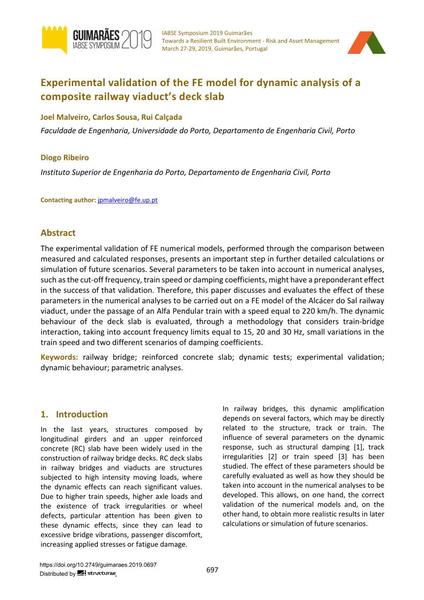Experimental validation of the FE model for dynamic analysis of a composite railway viaduct's deck slab

|
|
|||||||||||
Détails bibliographiques
| Auteur(s): |
Joel Malveiro
(Faculdade de Engenharia, Universidade do Porto, Departamento de Engenharia Civil, Porto)
Carlos Sousa (Faculdade de Engenharia, Universidade do Porto, Departamento de Engenharia Civil, Porto) Rui Calçada (Faculdade de Engenharia, Universidade do Porto, Departamento de Engenharia Civil, Porto) Diogo Ribeiro (Instituto Superior de Engenharia do Porto, Departamento de Engenharia Civil, Porto) |
||||
|---|---|---|---|---|---|
| Médium: | papier de conférence | ||||
| Langue(s): | anglais | ||||
| Conférence: | IABSE Symposium: Towards a Resilient Built Environment Risk and Asset Management, Guimarães, Portugal, 27-29 March 2019 | ||||
| Publié dans: | IABSE Symposium Guimarães 2019 | ||||
|
|||||
| Page(s): | 697-704 | ||||
| Nombre total de pages (du PDF): | 8 | ||||
| DOI: | 10.2749/guimaraes.2019.0697 | ||||
| Abstrait: |
The experimental validation of FE numerical models, performed through the comparison between measured and calculated responses, presents an important step in further detailed calculations or simulation of future scenarios. Several parameters to be taken into account in numerical analyses, such as the cut-off frequency, train speed or damping coefficients, might have a preponderant effect in the success of that validation. Therefore, this paper discusses and evaluates the effect of these parameters in the numerical analyses to be carried out on a FE model of the Alcácer do Sal railway viaduct, under the passage of an Alfa Pendular train with a speed equal to 220 km/h. The dynamic behaviour of the deck slab is evaluated, through a methodology that considers train-bridge interaction, taking into account frequency limits equal to 15, 20 and 30 Hz, small variations in the train speed and two different scenarios of damping coefficients. |
||||
| Mots-clé: |
pont ferroviaire
|
||||
